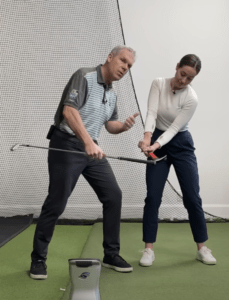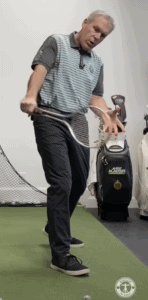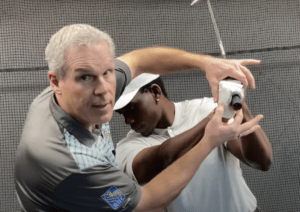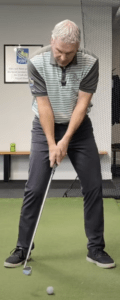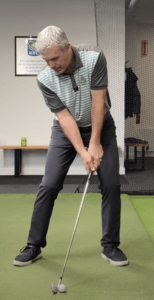stop slicing
Author: Eckhart Diestel
Date: April 13, 2021
This blog was adapted for personal use and can be utilized by any student Golf as a referral as to how the grip works in golf swing.
Key Notes:
- TAKE DEAD AIM
- the head ALIGNS
- the body ALIGNS
- the forearms ALIGN
- the wrists ALIGN
- the hands ALIGN
- TARGET
- COLLECT
- RELEASE
- ALIGN
Using A Hammer
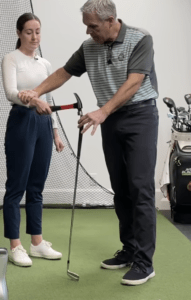
Examine how we use a hammer to drive a nail. Realize how the anatomy aligns with the direction of the blow. If you hit vertically downwards, the head and upper body will be right over the nail. The radius and the ulnar of the forearm will be in a stacked position on top of each other. The anatomical snuff box will be aligned with the free downward motion of the wrists and the base of the index finger will be on top of the shaft to support the downward motion.
If you hammer sideways, – imagine a nail in a door frame -, your entire anatomy will move to stay behind the blow and support the delivery of energy in the intended direction. The head and upper body tilt sideways. The radius and the ulnar of the forearm will still be stacked, now in the plane of
the blow. The anatomical snuff box and base of the index finger will remain aligned in that same target related plane.
Top Spin InTennis
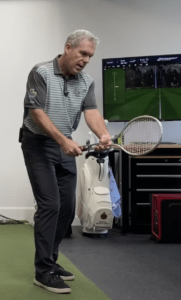
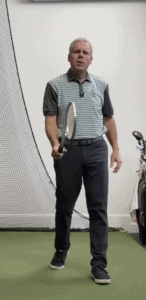
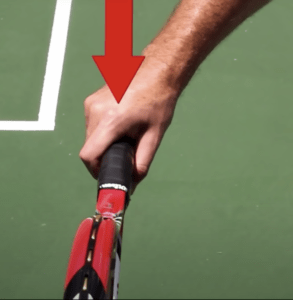
Notice that you grab the racket in a closed position to facilitate a strike with top spin. The racket is not brought into this position by a manipulation of the wrist, because the player wants to keep everything optimally aligned to delivery energy. Thus the wrist stays in the ’hammer’ orientation, while the racket is turned closed.
Bat With A Baseball
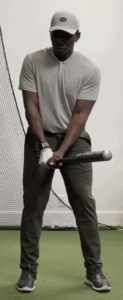
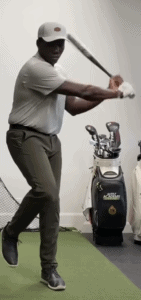
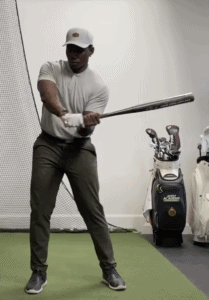
Hold the golf club just like you would hold a baseball bat be-cause this allows you to apply the maximum force. Again, the radius and ulnar are stacked in the plane of the hit direction. This may give the appearance of a cupped wrist at the top of the backswing. However, this is the anatomically correct position, because the wrist can hinge over the tabati ́ere anatomique ofboth hands. A cupped wrist position has the trail hand wrist flattened.
The orientation of the club face will determine how you feel the balance of the club in your hand. In a closed position the leading edge would appear in a picture in a horizontal position, in an open position the leading edge would point towards the ground. Thus, when you change you grip you will experience a difference in feel. Closing the club face moves the feel of the weight of the club head more unto your lead forearm. At the top of the backswing, the open position may feel more balanced and natural. This would be too open in relation to the target as the ball would be hit with that open face.
If you close the face about 45 degrees and swing it analogy to a base ball bat, you will see that the leading edge will be square to the path at impact. If your perceived task is to release the club to the target, the kinetic sequence will occur correctly. If the target is the ball, there will be no perceived need for a release towards a distant target and it will therefor not be performed.
We are releasing the club towards a target and are collecting the ball while we do so.
Just as much as a baseball players swings towards a target such as the fence at the end of the field; he will hit and compress the ball with the bat during that targeted motion. Hold the club in your lead hand with a grip that feels super tight and secure. When applying the trail hand, the index finger is placed correctly in a relation to the shaft that reminds you of holding a kitchen knife while pushing down on a cutting board
Extremely Important Is The Rotational Aspect.Extremely important is the rotational aspect of the release. Whether you apply a baseball swing or a tennis serve or a golf swing. Imagine to swing a golf club in a horizontally plane in front of you, letting forearms rotate naturally or ’turn over’ – the trail hand will turn over the lead hand.
The Movement Of The Hands And The
Direction Of Force
Inspect the movement of the hands and body position when you apply power in a direction. You will see that you will bring your body behind that blow. If you hammer straight down, your body will be entirely upright. If you blow an axe into the stem of a tree your body will bend to find a position that supports the direction of that blow. In this position you will see that the grip as well as the body are anatomically properly aligned.
Apply this to a golf club. If your target is the ball right in front of you, the blow will be directed straight down and your grip and body position will reflect that movement. If you task ist the release of a baseball bat to a distant target somewhere in the field, your body as well as your forearms as well as your wrist will line up behind the direction of that blow to apply maximum directed energy in that direction.
Care has to be taken of the leading edge of the club face now. If you start with a square position at the set up, the tilting to get behind the blow will dynamically bring the club face into an open position at impact. Therefor, the club face has to be held closed at setup to dynamically return it square at impact.
30 Yards – Between the release at the ball with a neutral grip and the release at the distant target with the correspondingly aligned anatomy accounts for a 30 yards difference in carry.
The Grip Is Too Strong

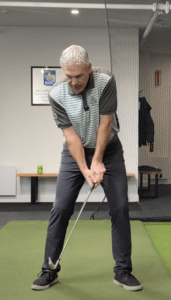
Now this is very important: if you bring the club face back to square with a twisting of your wirsts and tension in your forearms, you will notice that your body is still vertically upright, your radius and your ulnar are not stacked up and your tension, too strong 3 wrists can not move freely and conjunctly over the anatomical boxes. This is a too strong grip ! If you release and you relax from this position your club face will return too closed and you will hook the ball too much.
This will especially be the case if you release at the ball and not at the target. In a correctly alignment of the anatomy there will be a body tilt and no tension in the forearms. Early extension and casting both reflect a neutral grip and a release at the ball.
Take Dead Aim (Harvey Penick)


If you line up your anatomy ’behind’ your ’baseball’ blow with a specific distant target:
- your head will be in a specific position 20/20
- your body will tilt to stay behind the blow to apply its mass at impact
- the radius and ulna of both forearm will stack up in the plane of the swing
- the anatomical snuffboxes will be properly aligned and allow the wrist to hinge jointly and freely
- your trail hand will align to support the blow; the pressure point is at the base of your trail hand index.
- you collect
- after impact release your club just as a bat towards the distant target
- your forearms will be twisted over 180 degrees until their radius and the ulna reach a stacked position again at the top of the finish.
To facilitate the understanding: hold the club in front of you. Swing to hit an imaginary nail at chest height with the club face square. Hit the nail out of the park. There you go. Hit another nail at the side bottom of a door frame. Hit it out of the park as well. There is your golf swing.
For more awesome lessons such as this one click here for more important wisdom in golf.
Co-Author: Wisdom in Golf
THE MASTERS IS NEXT WEEK!! And the defending champion has a very enviable skill that so many of us would love to acquire: HOW TO FORGET THAT BAD SHOT AND MOVE ON WITH POSITIVITY AND CONFIDENCE!! The subject comes up often as to how the number 1 player in the world, Dustin Johnson, has the uncanny ability to forget bad shots immediately like water off a duck’s back, to allow him to bounce back with barrages of Birdies to keep his chances of winning very much alive.
This is an incredibly important skill to acquire and it is important to understand the science behind it to help with this difficult task. A couple of real experts in this field from the University of Nevada in Las Vegas and the University of Southern California, Gabriele Wulf and Rebecca Lewthwaite, have some terrific info on motor skill learning at this website: Gabriele Wulf Podcast
CHECK OUT THE NEW GOLF LEGACY CHANNEL BY BY OUR DIRECTOR OF INSTRUCTION FOR EUROPE, EDOUARD MONTAZ, and this week he is talking about Fred Couples and his Legacy! Golf Legacy Wisdom in Golf specializes in creating Golf Legacies, what will be your’s??
PLEASE GO CHECK OUT THIS NEW INTERACTIVE SOFTWARE FROM OUT FRIENDS AT RETRIEVE FOR THE BEST INTERACTIVE GOLF COACHING IN THE INDUSTRY. SIGN UP RIGHT NOW FOR WHAT BEST SUITS YOU AT:
• BEGINNER SERIES: Beginner
• CONSISTENCY SERIES: Consistency
• SENIOR SERIES: Senior
Golf Tips • Golf Instruction • Golf Lessons • Homepage | Premium Page
00:00 Shawn Introduces the Lesson w/ Sav & Mu
00:44 How to observe and analyze your golf shots w/ Mu
04:26 How the human mind utilizes its motor learning skills in relation to golf
09:00 How to observe and analyze your golf shots w/ Sav
11:20 What you should adapt to when you practice or play golf
12:57 Shawn summarizes the Lesson
Proud Partner of The Royal Bank of Canada: RBC
Proud Contributor and Partner of GolfWRX: Golf WRX
Head Director of Development at The Royal Quebec Golf Club: Golf Pros at The Royal
Follow me at ➡️Facebook
➡️Twitter

